Smoked Prime Rib Roast is ultimate holiday meal, and this is the best way to prepare this amazing holiday roast. We put together a comprehensive guide and video on smoking perfect Prime Rib Recipe every time.

Vindulge Recipe Highlights
- This recipe works for bone-in or boneless prime rib.
- You can use any smoker, from pellet grills to offsets, for this smoked prime rib recipe.
- Season the rib roast with an herbal paste for more flavor.
- If looking for something hot and fast check out our grilled prime rib recipe.
Prime Rib is one of the iconic celebratory or festive holiday meals. It’s dramatic, big in flavor, and delicious. Let’s be honest, it’s also an incredibly expensive cut of meat. So you want to make sure you get it right! If you are cooking this special occasion recipe for family or friends this holiday season this is your go-to guide to ensure a memorable meal.
[feast_advanced_jump_to]
The Process for Smoked Prime Rib
The end to end process for smoked prime rib is pretty simple.
- Season the roast. We use an herb paste in this recipe.
- Smoke the roast. Smoke it low and slow until the desired finishing temperature, which for us is medium rare.
- Let the roast rest. This is key to keep the moisture.
- Slice and Serve.
Smoking meat is low and slow — low heat and a slow cooking process. So when I say “smoking” that is what I am referring to. Smoking is synonymous with barbecue, but I like to be specific in the technique. Grilling is a high heat cooking method and not to be confused with low and slow. Each has its time and place, but for me holidays are all about low and slow.
Related Article: Reverse Seared Prime Rib
What is Prime Rib?
Technically it’s a beef rib roast that comes from the central part of the cow off of the spine. The movement of the cow gives this cut great marbling. It can go by many names, including:
- Prime Rib
- Standing Rib Roast
- Beef Rib Roast
- Ribeye Roast or Roll
- Bone-In or Boneless Roast
“Prime”, as it refers to the Prime Rib roast, is a reference to the primal cuts versus USDA prime rating. Primal cuts are the larger cuts after initial butchering.
Rating Prime Rib – USDA, Wagyu, Local
Quality, as defined by the USDA, is the marbling quality of beef, which in turn also impacts tenderness and flavor.
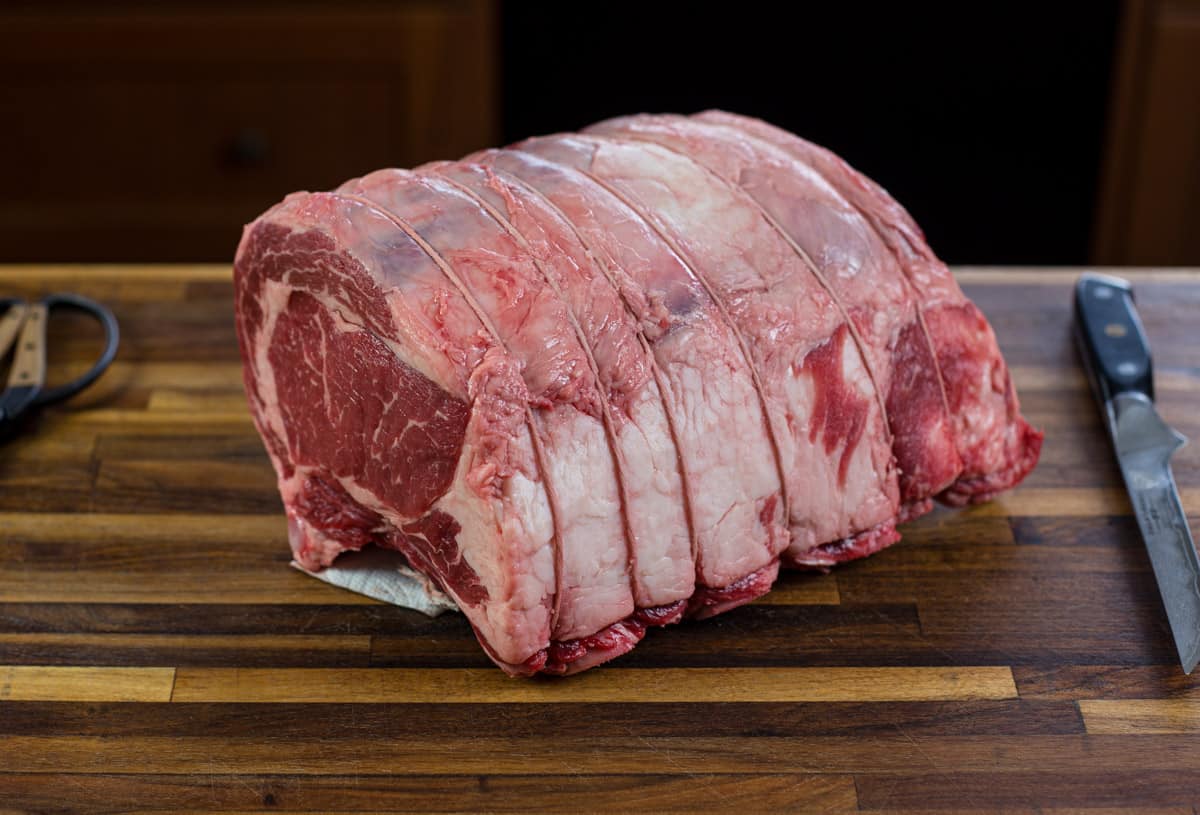
When talking to friends and family I can’t help but notice that some of the meat they are purchasing is not in fact “Prime”. So first, let us discuss the finer points of the rib roast so it’s easier to understand what you are buying and how much you are buying it for.
In order of grade of beef quality per USDA you have Prime, Choice and then Select.
While Prime is certainly the highest quality, Choice also has tremendous flavor and is definitely not an “inferior” meat. It just didn’t rise to the occasion of marbling and quality as the Prime. When you get to Select, you begin to see a difference in the meat, the fat content, and other factors. It is still worthy of smoking, but I would be sure if going down this route, consider at least a Choice cut for a smoked prime rib.
You can also buy American Wagyu, like from Snake River Farms. The marbling for American Wagyu is beyond Prime. And, being based in the Pacific Northwest, we love supporting our local ranchers and farmers. American Wagyu contains even more marbling and has an amazing buttery texture that is incredible. Snake River also has Prime and Choice cuts.
At some stores you may see labels outlining the rancher, or the type of feed (grass, grain, etc.). Don’t hesitate to ask if the beef is rated, and if it isn’t, at least discuss with the butcher that you are looking for a Choice or Prime quality cut or its equivalent. Grain finishing adds marbling. Strictly grass fed beef will tend to be leaner and with less marbling.
Ranchers elect to have their beef rated this way. So you may have a local rancher with Prime quality beef, but haven’t paid for the stamp (it will have passed USDA inspection, just not getting a rating). That’s why looking at the actual marbling is key so you can make the best decision that works for your budget and quality.
Finally, look closely at the labeling. In the end it may say “Prime Rib of Beef” or “Standing Beef Rib Roast for Prime Rib” according to the USDA but not have to be derived from Prime grade beef. So when in doubt ask the butcher.
How to Select a Prime Rib
- Select the Size of Roast: When shopping for a roast for an event or party, we plan 1 pound of meat per person (pre-cook weight).
- What is your Budget: Having a budget can help guide where you want to find the most quality for the money. Look online if you aren’t finding what you want locally.
- Consider the Marbling: Look at the intramuscular fat. Be sure there is healthy marbling, but still a good amount of meat.
- Bone-In or Boneless: If buying bone-in, typically order the roast by number of rib bones, like a 3-bone rib roast. Bone-in has the benefit of a layer between the heat source and the meat to protect the meat while cooking.
There is no flavor difference between bone-in or boneless (so don’t let anyone tell you there is). The difference comes in presentation and having a small layer between the grill, the bones, and the rib roast.
The flavor differences are going to be defined by the quality of meat and marbling vs. whether or not your roast is boneless or bone-in.
Ordering prime rib online also makes it easy so it is delivered right to you in time for your meal.
Preparing a Prime Rib for Smoking
- Start by trimming away the excess fat cap off the outer roast if it is hanging or loose. There is plenty of marbling inside that rib roast to give flavor. By removing excess fat, it helps get seasoning closer to the meat.
- After trimming the fat, pat the roast dry. It’s not uncommon for the butcher to have trimmed off the bones already from the roast (and thus it is tied together with string). Be sure when you clean it, you include this area as well. Then the seasoning begins.
- If the bones have not been removed, you can do this now, or after the cook. Simply cut along the bone slowly to separate. Tie back using butchers twine to keep them together.
Prime Rib Seasoning
Start with a coat of olive oil and then finish with salt and pepper. Sound simple? It is, and this is due to the amazing flavor you get from the fat rendering as you slowly cook the meat. Want to add another layer of flavor? Consider a flavorful herb paste of olive oil, crushed garlic, thyme, sage, and rosemary for your Smoked Prime Rib, such as the one below.

A paste is simply a wet rub. Just blend all of the ingredients together in a food processor. It sticks easier to the meat, and when using smoke, the moisture from the paste helps the flavor adhere to the meat.
Remember to also season within that area of the bone that was removed by the butcher, coat everywhere. Seriously, be LIBERAL with your paste and seasonings! You can season the roast the day you will cook it or prep the day before.
Double this herb paste recipe if the roast is over 5 pounds.
Side note: I don’t have the bone removed prior to cooking, instead I cut it out after it’s done cooking. This is just my preference.

How to Smoke a Prime Rib
Whether you use a pellet smoker, electric, or a wood and coal based smoker, the technique is the same for this Smoked Prime Rib recipe.
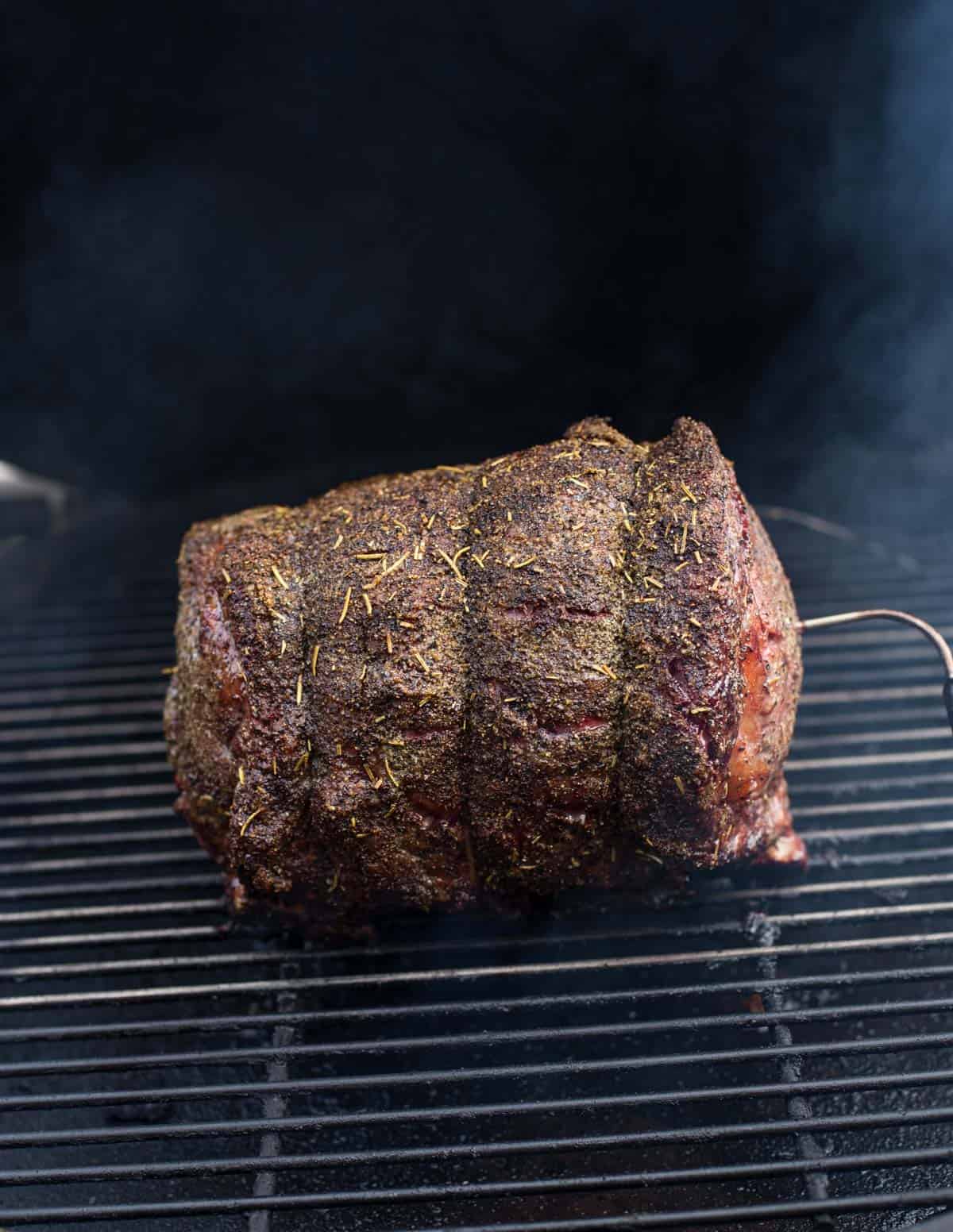
- Prepare your fire in your smoker. The key is keeping the temperature in the cooking chamber at 225 degrees throughout the cooking process.
- Place the seasoned prime rib roast onto the smoker when it comes to temperature. I do this straight from the fridge. When smoking, the cooler meat will warm as it cooks and the colder temperature actually will infuse more smoke flavor than a roast that has been standing a while at room temperature. The reason is that it sweats as it goes from cold to warm, and that liquid helps with the smoke flavor.
- Smoke the roast until the internal temperature of the meat, when measured at the center, is at your desired level; I like 125 degrees for rare and 135 for medium rare.
- Once you pull the smoked prime rib roast from the smoker, tent the roast in aluminum foil and allow 30 minutes for the meat to rest. The temperature will continue to rise another 5 degrees or so and while the meat rests, the cells will reabsorb the juices as it cools keeping the sliced meat moist.
- Carve and serve with your favorite sides.
Always use a good instant read meat thermometer for a cut like this for a proper read. We love the Thermapen One for its quick and accurate read as well as the Thermoworks Smoke Unit to monitor the temperature throughout the cooking process.
Chef’s Tip: Remember, when cooking in a smoker or grill, you always cook to temperature and not time.
Slicing Rib Roast
Remove the foil and then remove the strings (if you wrapped your roast). Next, remove the bones from the prime rib roast (see video for how we do this). As much as I love the bone, I find a much more elegant (and easier) presentation without the bone. Place the roast on a cutting board and slice into desired thickness. Plate and serve with your favorite sides.
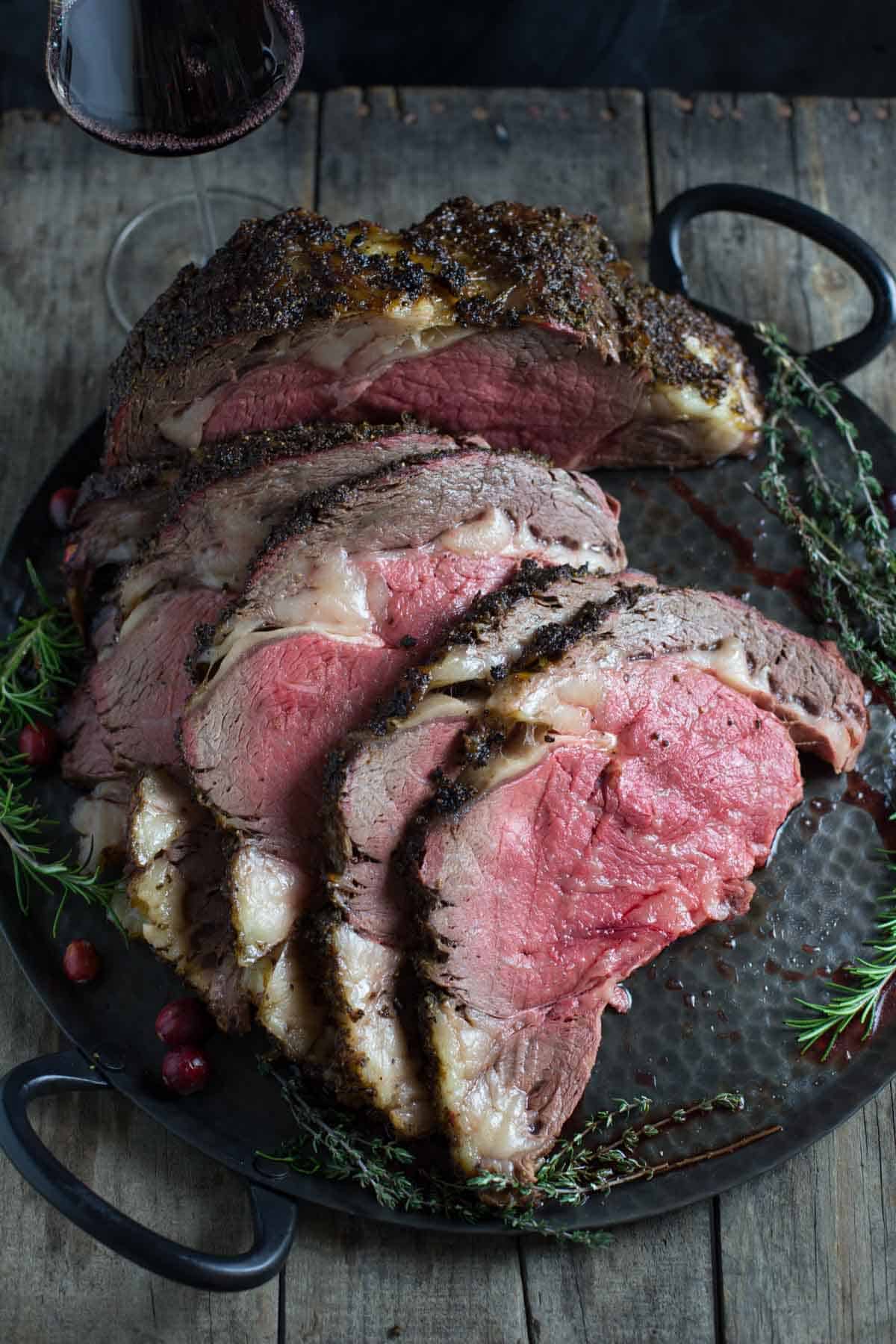
The great part of a Prime Rib Roast is the ability to cook the outer edges to medium while the center can be rare. So you can please a wide audience without over cooking the entire roast if some of your guests prefer a more med-well done slice.
How Long to Smoke Prime Rib
All time ranges are based on a finished internal temperature of 130 degrees Fahrenheit. As a reminder when cooking at low temperature, the guide to when the meat is done is the internal temperature, not the exact timing.
- 225 Degrees will take roughly 40 minutes per pound
- 250 Degrees will take roughly 30 minutes per pound
- 275 Degrees will take roughly 20 minutes per pound
The following times are a rough guide for how long a prime rib will take to smoke at 225 degrees F.
- 4 Pound Prime Rib = 2.6 hours
- 6 pound Prime Rib = 4 hours
- 8 pound Prime Rib = 5.3 hours
- 10 pound Prime Rib = 6.6 hours
Chef’s Tip: Be sure to add 30 minutes of resting time to the cooking time. If your rib roast is done early, then wrap the roast in butcher paper or a towel and place into a cooler with no ice. The roast will stay warm for up to four hours.
Sorry holiday ham… sometimes you just need to change things up. Be the hero this holiday season and wow your friends and family with this ultimate Smoked Prime Rib recipe and guide.
Beef Temperature Chart
Always cook beef to temperature, not time. Here is the Vindulge beef temperature chart for reference. For a large roast there will be carry over cooking, anywhere from 5-7 degrees from when you remove the roast from the smoker.
- Rare: 120-130 degrees F
- Medium Rare: 130-140 degrees F
- Medium: 140-150 degrees F
- Medium Well: 150-160 degrees F
- Well Done: 160 degrees F (and not recommended)
Prime Rib Wine Pairing
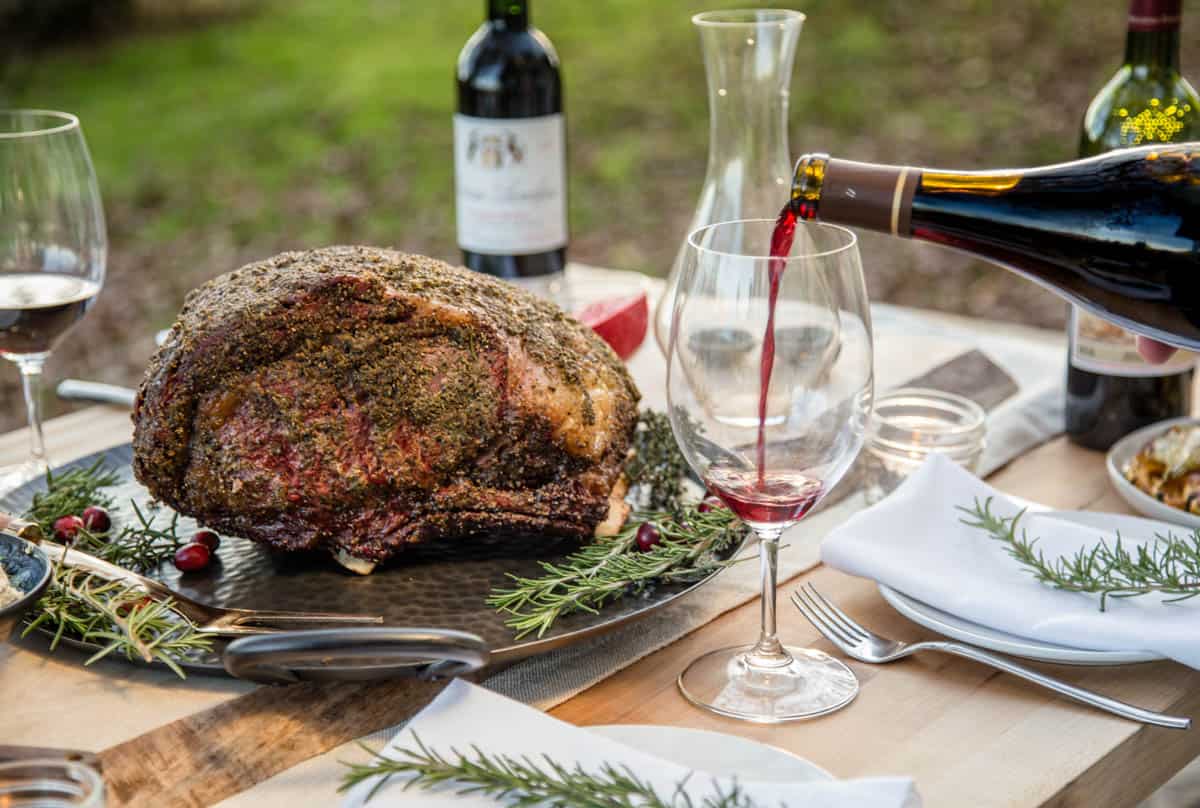
The best wine with Prime Rib is a big red such as a California Cabernet Sauvignon, Bordeaux, Merlot, or Malbec. You can read more about pairing wine with Beef Rib Roast, where we discuss all things wine and smoked prime rib.
You can also shop the perfect holiday wines at our own Vindulge Wine Marketplace.
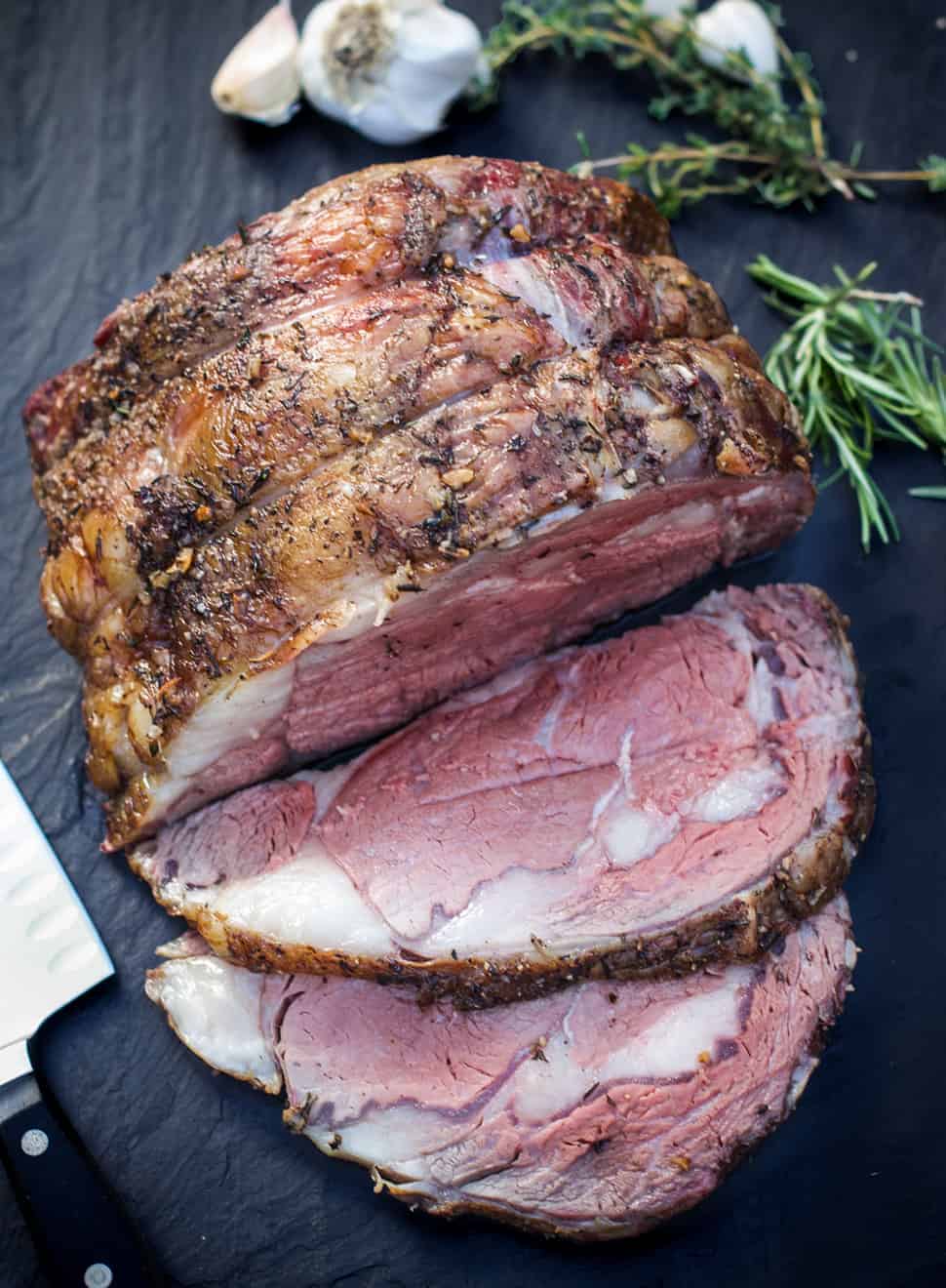
Leftover Prime Rib Ideas
Holiday Meal Planning Ideas
Explore our entire article on holiday recipes for the grill and smoker for more holiday roast inspiration, appetizers, and cocktails. Here are some of our favorites.
- Mulled Wine Recipe
- Roasted Chestnuts Over Open Fire
- Grilled Bacon Wrapped Dates
- Duck Fat Roasted Potatoes
- Grilled Brussels Sprouts Recipe

*This post contains an affiliate link for the Thermapen Mk4 digital read thermometer and Snake River Farms. We only recommend products we use and love! And you can’t smoke meat to the perfect temperature without one! Seriously, the folks who cook to touch? No! You can always be certain if you have good thermometer and this one is awesome.
This post was originally published December of 2016, and updated with new details in September 2022. The original recipe remains the same.
If you like this recipe we’d truly appreciate it if you would give this recipe a star review! And if you share any of your pics on Instagram use the hashtag #vindulge. We LOVE to see it when you cook our recipes.
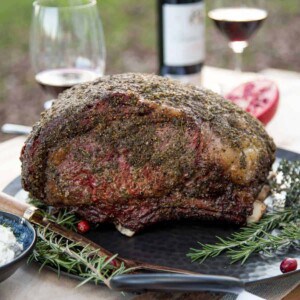
Smoked Prime Rib Recipe with Herb Paste
#wprm-recipe-user-rating-0 .wprm-rating-star.wprm-rating-star-full svg * { fill: #ffffff; }#wprm-recipe-user-rating-0 .wprm-rating-star.wprm-rating-star-33 svg * { fill: url(#wprm-recipe-user-rating-0-33); }#wprm-recipe-user-rating-0 .wprm-rating-star.wprm-rating-star-50 svg * { fill: url(#wprm-recipe-user-rating-0-50); }#wprm-recipe-user-rating-0 .wprm-rating-star.wprm-rating-star-66 svg * { fill: url(#wprm-recipe-user-rating-0-66); }linearGradient#wprm-recipe-user-rating-0-33 stop { stop-color: #ffffff; }linearGradient#wprm-recipe-user-rating-0-50 stop { stop-color: #ffffff; }linearGradient#wprm-recipe-user-rating-0-66 stop { stop-color: #ffffff; }
Ingredients
For the Prime Rib:
- 5 pound Prime Rib Roast (or rib roast)
- ¼ cup extra virgin olive oil
- 2 tablespoons coarse ground pepper
- 2 tablespoons kosher salt
For the Herb Paste:
- 3 cloves of garlic
- 1 tablespoon fresh rosemary
- 1 tablespoon fresh thyme
- 1 tablespoon fresh sage
- ¼ cup extra virgin olive oil
Instructions
For the Herb Paste:
-
Place all herb paste ingredients into a food processor and pulse a few times until combined into a chunky paste. (double recipe if roast is over 5 pounds)
For the Smoked Prime Rib:
-
If the bone has already been removed remove the string and bone to trim excess fat off of meat, and pat dry. Using butchers twine, tie the bones back onto the roast. If the bone has not been removed simply remove it after cooking.
-
Season Roast: Apply olive oil and salt and pepper generously to the rib roast. Then apply the paste. Store overnight in the refrigerator to allow the seasoning to incorporate into the meat (if possible).
-
Preheat Smoker: to 225 degrees using a fruit wood like apple or cherry (oak also works well).
-
Smoke Roast: Place the seasoned rib roast on the smoker, bone side down (this acts as heat shield). Insert any Bluetooth thermometer at this time to monitor the ongoing temperature of the roast while cooking, like the Thermoworks Smoke Unit.
-
Continue cooking roast for roughly 3 ½ hours or until the center of the meat reads 125 degrees F using an instant read thermometer for rare. (At 225 degrees plan 40 minutes cooking time per pound). Use an instant read thermometer to probe in multiple areas toward the center of the cut. See notes for temperature chart.
-
Rest: Remove Prime Rib from smoker and let sit, tented in foil, for 30 minutes.
-
Slice and serve.
Video
Notes
If the roast is done early, wrap in butcher paper, a towel, or foil and place into a cooler with no ice. It will act as a warmer for several hours prior to serving.
Beef Temperature Chart:
- Rare: 120-130 degrees F
- Medium Rare: 130-140 degrees F
- Medium: 140-150 degrees F
- Medium Well: 150-160 degrees F
- Well Done: 160 degrees F (and not recommended)
Find the perfect wine pairing at the Vindulge Wine Shop
Nutrition
The post The Best Smoked Prime Rib Recipe and Video appeared first on Vindulge.


